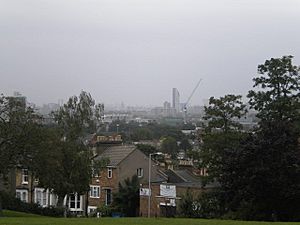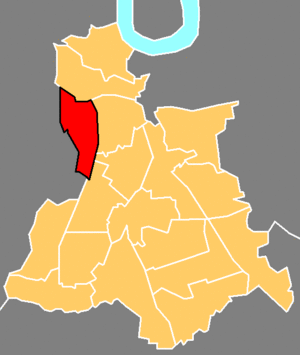Telegraph Hill, Lewisham facts for kids
Quick facts for kids Telegraph Hill |
|
|---|---|
 View of central London from Telegraph Hill Park |
|
| Population | 16,414 (2011 Census. Ward) |
| OS grid reference | TQ359760 |
| London borough | |
| Ceremonial county | Greater London |
| Region | |
| Country | England |
| Sovereign state | United Kingdom |
| Post town | LONDON |
| Postcode district | SE14 and SE4 |
| Dialling code | 020 |
| Police | Metropolitan |
| Fire | London |
| Ambulance | London |
| EU Parliament | London |
| UK Parliament |
|
| London Assembly |
|
Telegraph Hill is a neighborhood in southeast London, England. It's a special 'conservation area' because of its unique buildings. It's located in the London Borough of Lewisham, near Nunhead, Brockley, and New Cross.
Contents
What is the History of Telegraph Hill?
Telegraph Hill is a hill that goes up to about 50 meters (164 feet) high. It used to be called Plowed Garlic Hill. It got its current name from a special communication station.
The Old Telegraph Station
Around 1795, a semaphore telegraph station was built on top of the hill. This station was like an old-fashioned way to send messages quickly. It was one of the places that helped send the news of Wellington's victory at Waterloo to London. This important station was removed in 1823.
Famous People and Gardens
The famous poet Robert Browning once lived at the bottom of Telegraph Hill. He described his small house as looking like a 'goose pie'.
For many years, Telegraph Hill was covered with market gardens. These gardens were owned by the Worshipful Company of Haberdashers. This is one of London's very old and important trade groups.
Building Homes and Schools
In the late 1800s, the Haberdashers decided to build homes on Telegraph Hill. They wanted to create nice houses on wide streets with trees. Most of these houses were built around 1871. The homes have a special style, which is why Telegraph Hill is now a conservation area. This means the area's unique look is protected.
The company also built schools for boys and girls. These were called Haberdashers' Aske's School. They were named after Robert Aske, an important member of the company. Today, these schools are known as Haberdashers' Hatcham College. St Catherine's Church was also built in 1894.
In 1895, Telegraph Hill Park was opened for everyone to enjoy.
St Catherine's Church
St Catherine's Church was built in 1893 on top of Telegraph Hill. It was designed by the Haberdashers Company's surveyor. Sadly, the church was destroyed by fire on May 6, 1913. It was later rebuilt and is the church you see today. It was also damaged during World War 2 but repaired.
Community Work at the Church
In 1993, the church leaders and local people started the Telegraph Hill Festival. The church, working with the Telegraph Hill Centre, also helped create a cafe. This cafe is part of the church's site and helps the community.
Telegraph Hill Centre
The Telegraph Hill Centre was built in 1971 and opened in 1972. Famous people like Bishop Trevor Huddleston and actress Glenda Jackson were there for the opening. The local council stopped funding the center in 1986/87. After that, St Catherine's Church took over its ownership and funding.
The center is now funded by itself. It continues to offer services and activities for the community in Telegraph Hill and nearby areas.
Telegraph Hill Festival
The Telegraph Hill Festival ran for 25 years. It included many fun events like music, plays, and art shows. Artists in the area would also open their studios for people to visit. In its last five years, up to 2019, the festival became very popular. It was known for getting many people involved from the community.
Telegraph Hill Park
Telegraph Hill Park is split into two parts by Kitto Road.
Upper Park Features
The upper part of the park has tennis courts. These courts are believed to be where the original telegraph station once stood. This upper section is the only part of the park where dogs are allowed. It's a popular spot for local people to watch the New Year's fireworks. This is because it has a great view of the London skyline.
Lower Park Features
The lower part of the park has ponds and playgrounds for children. There's also a concrete area for ball games. You can also find a statue of Olaudah Equiano here. A farmers' market is held in the lower park every Saturday from 10 AM to 3 PM.
Schools in Telegraph Hill
Telegraph Hill is home to several schools.
Haberdashers' Hatcham College
The Haberdashers' Hatcham College is located here. In front of the Haberdasher's Boys' School, there is a special statue. It's made of Coade stone and shows Robert Aske. He was a merchant and haberdasher who lived from 1619 to 1689. He is remembered for setting up the charitable foundation that runs the Haberdashers' Schools today. The statue was made in 1836. It shows him in his company robes, holding plans for buildings.
Other Schools
Another secondary school, Telegraph Hill School, closed in 2003. Local parents tried to get the council to build a new secondary school there, but it didn't happen. Instead, a sixth form center called Crossways Sixth Form was built and opened in 2004. In 2013, Christ the King Sixth Form College took over the site. Telegraph Hill also has a primary school called Edmund Waller Primary School.
What is the Population of Telegraph Hill?
Compared to London and England as a whole, many people living in Telegraph Hill are young. Most residents are 34 years old or younger. There are fewer people in the older age groups.
About 51% of the people in Telegraph Hill are white. About 8% are Asian or Asian British, and 30% are Black, African, Caribbean, or Black British. The area of Lewisham, where Telegraph Hill is located, is very diverse. About two out of every five residents are from a Black, Asian, or other ethnically diverse background.







